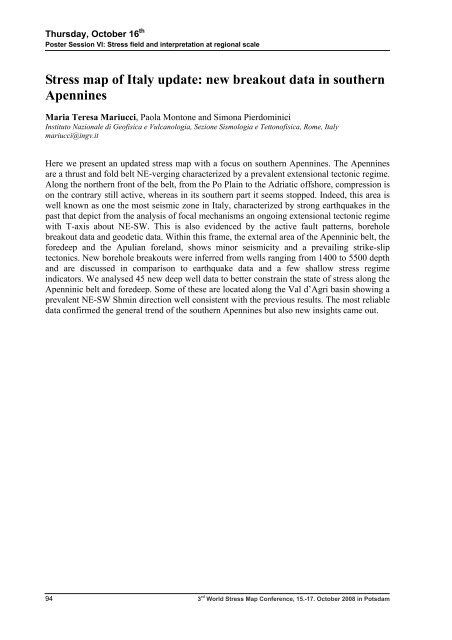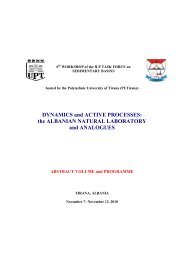World Stress Map Conference - International Lithosphere Program ...
World Stress Map Conference - International Lithosphere Program ...
World Stress Map Conference - International Lithosphere Program ...
Create successful ePaper yourself
Turn your PDF publications into a flip-book with our unique Google optimized e-Paper software.
Thursday, October 16 th<br />
Poster Session VI: <strong>Stress</strong> field and interpretation at regional scale<br />
<strong>Stress</strong> map of Italy update: new breakout data in southern<br />
Apennines<br />
Maria Teresa Mariucci, Paola Montone and Simona Pierdominici<br />
Instituto Nazionale di Geofisica e Vulcanologia, Sezione Sismologia e Tettonofisica, Rome, Italy<br />
mariucci@ingv.it<br />
Here we present an updated stress map with a focus on southern Apennines. The Apennines<br />
are a thrust and fold belt NE-verging characterized by a prevalent extensional tectonic regime.<br />
Along the northern front of the belt, from the Po Plain to the Adriatic offshore, compression is<br />
on the contrary still active, whereas in its southern part it seems stopped. Indeed, this area is<br />
well known as one the most seismic zone in Italy, characterized by strong earthquakes in the<br />
past that depict from the analysis of focal mechanisms an ongoing extensional tectonic regime<br />
with T-axis about NE-SW. This is also evidenced by the active fault patterns, borehole<br />
breakout data and geodetic data. Within this frame, the external area of the Apenninic belt, the<br />
foredeep and the Apulian foreland, shows minor seismicity and a prevailing strike-slip<br />
tectonics. New borehole breakouts were inferred from wells ranging from 1400 to 5500 depth<br />
and are discussed in comparison to earthquake data and a few shallow stress regime<br />
indicators. We analysed 45 new deep well data to better constrain the state of stress along the<br />
Apenninic belt and foredeep. Some of these are located along the Val d’Agri basin showing a<br />
prevalent NE-SW Shmin direction well consistent with the previous results. The most reliable<br />
data confirmed the general trend of the southern Apennines but also new insights came out.<br />
94 3 rd <strong>World</strong> <strong>Stress</strong> <strong>Map</strong> <strong>Conference</strong>, 15.-17. October 2008 in Potsdam




